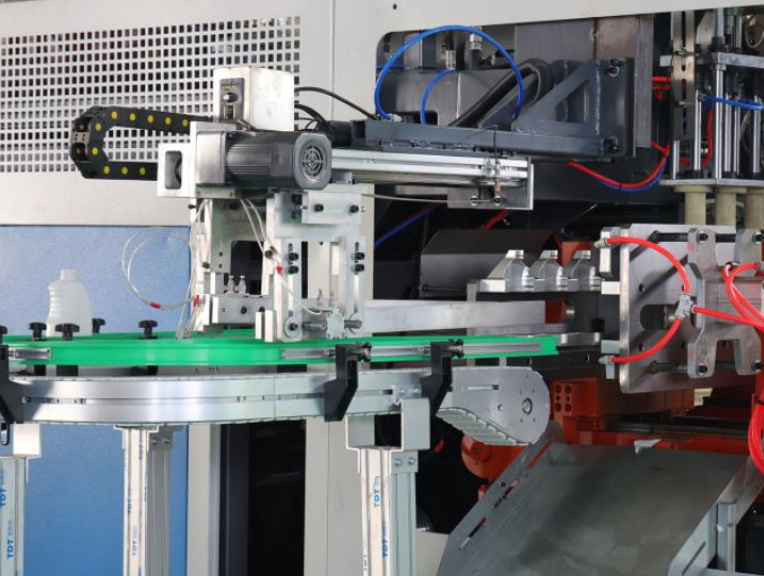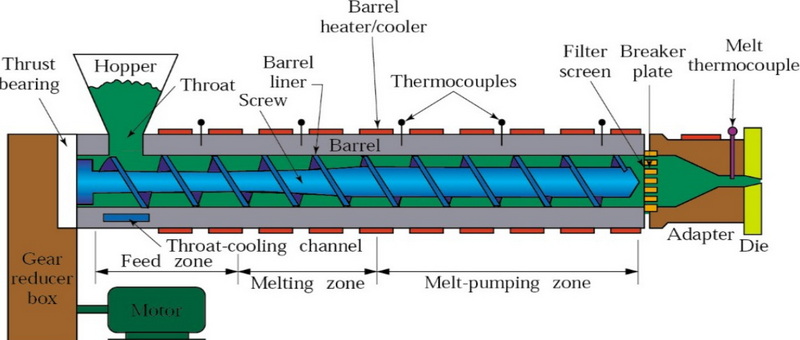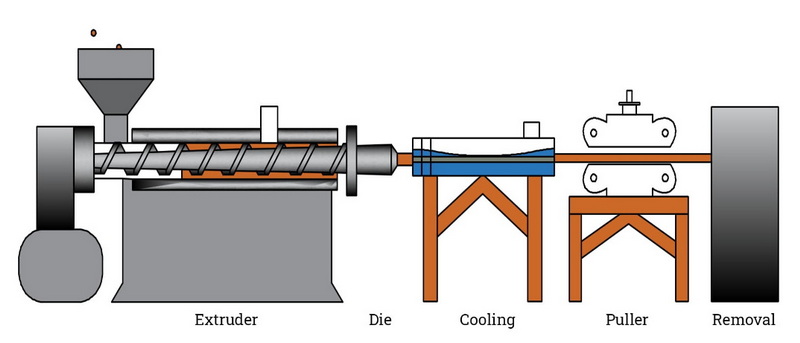Content Menu
● Introduction to Automatic Plastic Extrusion Machines
>> Components of an Automatic Plastic Extrusion Machine
>> Working Principle of an Automatic Plastic Extrusion Machine
● Applications of Automatic Plastic Extrusion Machines
>> Common Issues with Automatic Plastic Extrusion Machines
● Advancements in Plastic Extrusion Technology
● Maintenance and Troubleshooting
>> Troubleshooting Strategies
● Conclusion
● FAQs
>> 1. What are the primary components of an automatic plastic extrusion machine?
>> 2. How does the extruder screw contribute to the melting of plastic?
>> 3. What types of products can be made using an automatic plastic extrusion machine?
>> 4. What are common issues encountered with automatic plastic extrusion machines?
>> 5. How is the molten plastic cooled and solidified after exiting the die?
● Citations:
The automatic plastic extrusion machine is a sophisticated piece of equipment used in the manufacturing industry to produce a wide range of plastic products, such as pipes, tubes, films, and sheets. This machine operates based on a principle that involves melting plastic pellets and shaping them into continuous profiles. In this article, we will delve into the working principle of an automatic plastic extrusion machine, its components, applications, and common issues that may arise during operation.

Introduction to Automatic Plastic Extrusion Machines
Plastic extrusion is a high-volume manufacturing process that transforms raw plastic into a continuous profile. The automatic plastic extrusion machine is designed to automate this process, ensuring efficiency and consistency in production. It consists of several key components, each playing a crucial role in the extrusion process.
Components of an Automatic Plastic Extrusion Machine
1. Hopper: This is where raw plastic material, typically in the form of pellets, is loaded. The hopper feeds the material into the barrel of the extruder.
2. Barrel: The barrel houses the extruder screw and is equipped with heaters to melt the plastic. It is designed to withstand high pressure and temperatures.
3. Extruder Screw: This rotating screw carries the plastic pellets from the hopper to the other end of the barrel. Its rotation generates heat through friction, melting the plastic.
4. Heaters: Located along the barrel, these aid the screw in melting the plastic and maintaining the necessary temperature for extrusion.
5. Die: The die gives shape to the molten plastic. It is a customized part of the machine, specifically designed according to the profile of the product to be manufactured.
6. Cooling System: After being shaped by the die, the plastic needs to be cooled and solidified. This system may include fans, water baths, or cooling rollers.
7. Cutter: This component cuts the newly formed plastic into the required lengths. Depending on the product, the edge may be a simple guillotine or a more complex rotary cutter.
Working Principle of an Automatic Plastic Extrusion Machine
The process begins with the feeding of raw plastic material into the hopper. The material is then conveyed into the barrel by the extruder screw, where it is melted due to the heat generated by the friction of the screw's rotation and the external heaters. The molten plastic is then forced through a die, which shapes it into the desired profile. After exiting the die, the plastic is cooled and solidified by the cooling system. Finally, it is cut into the required lengths by the cutter.
Applications of Automatic Plastic Extrusion Machines
These machines are widely used in various industries for producing different types of plastic products:
- Pipes and Tubing: Used in plumbing, drainage, and irrigation systems.
- Insulation: Used for electrical cables and wires.
- Window and Door Frames: Due to their durability and weather resistance.
- Automotive Parts: Components like interior trim, door seals, and weatherstripping.
- Construction Materials: Vinyl siding, plastic lumber, and fence panels.
- Packaging: Shrink wrap and clamshell packaging.
- Medical Devices: Precision components such as catheters and syringes.
Each application takes advantage of the process's ability to form plastic into complex shapes and long, continuous lengths. The diverse capabilities of plastic extrusion have made it an indispensable part of modern manufacturing[1][2].
Common Issues with Automatic Plastic Extrusion Machines
Despite their efficiency, automatic plastic extrusion machines can encounter several issues during operation:
1. Unstable Current: Caused by uneven feeding, damaged motor bearings, or faulty heaters.
2. Motor Failure to Start: Often due to incorrect driving procedures or electrical issues.
3. Blocked Machine Head: Resulting from poor material plasticization or foreign objects in the system.
4. High Startup Current: Caused by insufficient heating time or large torque.
5. Abnormal Motor Sounds: Indicative of bearing damage or electrical component failure.
For more details on troubleshooting these issues, refer to[4][7].

Advancements in Plastic Extrusion Technology
Recent years have seen significant advancements in plastic extrusion technology, improving both efficiency and quality:
1. Twin-Screw Extruders: These offer superior mixing capabilities, broadening the range of materials that can be extruded and enhancing output uniformity[1].
2. Intelligent Control Systems: Enable precise regulation of process parameters like temperature and pressure, improving quality consistency and reducing defects[1].
3. Advanced Die Design: Allows for multi-layer extrusion, enhancing product functionality by combining different plastic characteristics in a single run[1].
4. High-Performance Materials: The use of high-performance plastics extruders is expanding applications in automotive, aerospace, and medical sectors, enabling the creation of complex parts and lightweight materials[2].
Maintenance and Troubleshooting
Regular maintenance is crucial for extending the lifespan of automatic plastic extrusion machines:
1. Cleaning and Lubrication: Regular cleaning of components like the hopper, barrel, and screw, along with lubrication of moving parts, helps reduce wear and tear[6][8].
2. Temperature Control: Ensuring accurate temperature control is vital for maintaining product quality and preventing issues like temperature variations[11].
3. Preventive Maintenance: Scheduling regular inspections and replacements of worn parts can prevent major breakdowns and maintain operational efficiency[6][8].
Troubleshooting Strategies
- Elevated Engine Amperage: Check for low melt temperatures, inappropriate resin selection, or system contamination[5].
- Discontinuous Material Outlet: Address hopper clogs, bridging, or cooling jacket malfunctions[5].
- Uneven Flow (Surging): Adjust heating zone temperatures and inspect for contamination[5].
- No Material Outflow: Check the hopper, screw, screen pack, and extrusion die for blockages[5].
Conclusion
The automatic plastic extrusion machine is a vital tool in modern manufacturing, offering a versatile and efficient method for producing a wide range of plastic products. Understanding its working principle and components is essential for optimizing production processes and addressing common faults. As technology continues to evolve, these machines will play an increasingly important role in meeting the demands of various industries.

FAQs
1. What are the primary components of an automatic plastic extrusion machine?
The primary components include the hopper, barrel, extruder screw, heaters, die, cooling system, and cutter. Each component plays a crucial role in the extrusion process.
2. How does the extruder screw contribute to the melting of plastic?
The extruder screw contributes to the melting of plastic by generating heat through friction as it rotates. This heat, combined with external heating from the barrel, melts the plastic pellets.
3. What types of products can be made using an automatic plastic extrusion machine?
Products include pipes, tubes, films, sheets, weatherstripping, fencing, deck railings, window frames, thermoplastic coatings, and wire insulation.
4. What are common issues encountered with automatic plastic extrusion machines?
Common issues include unstable current, motor failure to start, blocked machine heads, high startup currents, and abnormal motor sounds.
5. How is the molten plastic cooled and solidified after exiting the die?
The molten plastic is cooled and solidified using a cooling system that may include fans, water baths, or cooling rollers.
Citations:
[1] https://jieyatwinscrew.com/blog/everything-you-need-to-know-about-plastic-extrusion-machines/
[2] https://plastic-extrusionmachines.com/high-performance-plastics-extruders-lead-to-breakthroughs-in-new-material-applications/
[3] https://www.summitsystems.co.uk/plastics-automation/extrusion-lines-recycling-plants/extrusion-lines/
[4] https://www.jwellextrusions.com/common-faults-of-extrusion-machine-and-the-related-causes.html
[5] https://www.plasticsengineering.org/2024/05/extrusion-troubleshooting-key-drivers-part-1-of-3-004709/
[6] https://jieyatwinscrew.com/blog/the-ultimate-guide-to-plastic-extruder-machines/
[7] https://www.jwellmachine.com/analysis-and-solution-of-common-failures-of-plastic-extruder/
[8] https://www.medicalextruders.com/info/extrusion-equipment-maintenance-method-24455647.html
[9] https://www.qiangshengplas.com/news/common-faults-analysis-of-plastic-extruders/
[10] https://www.jwellmachine.com/winter-maintenance-tips-for-plastic-extrusion-equipment/
[11] https://www.bausano.com/en/press-and-news/common-problems-in-the-plastic-extrusion-process
[12] https://www.adremac.com/complete-guide-to-pipe-extrusion-machinery-equipment-and-advanced-cutting-solutions/
[13] https://ptfe-machinery.com/plastic-extrusion-machines-introduction-types-application/
[14] https://plasticsheetextruder.en.made-in-china.com/product/BdfawDijrHTb/China-Advanced-Plastic-Extrusion-Technology-System.html
[15] https://www.jwellmachine.com/analysis-of-plastic-extrusion-technology/
[16] https://granuleplus.com/plastic-extruder-machine/
[17] https://www.fictiv.com/articles/plastic-extrusion-explained
[18] https://www.prm-taiwan.com/blog/plastic-extrusion-machine--how-shape-diverse-industries_423
[19] https://cgmachinery.en.made-in-china.com/product/yBmnGoMxIApP/China-Advanced-Extrusion-Technology-Plastic-Extruder-for-Making-PS-Profile.html
[20] https://www.macocorporation.com/blog/extruder-machine/
[21] https://www.globenewswire.com/news-release/2025/02/05/3021359/0/en/Plastic-Extrusion-Machine-Market-to-Grow-at-4-7-CAGR-During-2025-2035-Boosting-Global-Industry-to-USD-12-343-2-Million-by-2035-Future-Market-Insights-Inc.html
[22] https://blog.goldsupplier.com/plastic-extrusion-machines/
[23] https://www.iqsdirectory.com/articles/plastic-extrusion.html
[24] https://www.adremac.com/understanding-extruder-machines-key-technologies-applications-and-why-they-matter/
[25] https://api.pageplace.de/preview/DT0400.9781569907764_A38515627/preview-9781569907764_A38515627.pdf
[26] https://saratech.com/2024/05/plastic-extrusion-issue-troubleshooting-markforged-industrial-desktop-3d-printers/
[27] https://www.jwellextrusions.com/tips-for-maintaining-plastic-extrusion-equipment-in-winter.html
[28] https://www.ulprospector.com/knowledge/9293/pc-predictive-maintenance-troubleshooting-plastics-extrusion-equipment/
[29] https://www.nordson.com/en/about-us/nordson-blog/polymer-processing-systems-blogs/2023-04-06-cleaning-your-extrusion-die
[30] https://www.extrusion-training.de/en/22/
[31] https://www.linkedin.com/pulse/how-do-maintenance-plastic-extruders-farooq-rasheed-ansari-baba--xj7pf
[32] https://www.chinatplast.com/company-news/common-problems-and-corresponding-solutions-during-the-extrusion-process-of-film-extruder-machines
[33] https://www.maintwiz.com/daily-maintenance-checklist-for-extruders/
[34] https://www.fangliextru.com/news-show-1069370.html
[35] https://www.accextrusion.com/news/operating-plastic-profile-extrusion-machines/
[36] https://www.linkedin.com/pulse/common-problems-twin-screw-extrusion-equipment-echo-wang
[37] https://www.apollo-china.com/industry-news/working-principle-and-workflow-of-extrusion-blow-molding-machine/
[38] https://www.moldingmachinetepai.com/news/what-are-the-applications-of-extrusion-blow-molding.html
[39] https://www.jwellmachine.com/mechanical-principle-of-extruder%EF%BF%BC/
[40] https://engitech.in/extrusion-machines-and-extruders-guide/






















